
Originally published in The Clarinet 52/4 (September 2025).
Copies of The Clarinet are available for ICA members.
Book and Music Reviews:
September 2025
BOOKS
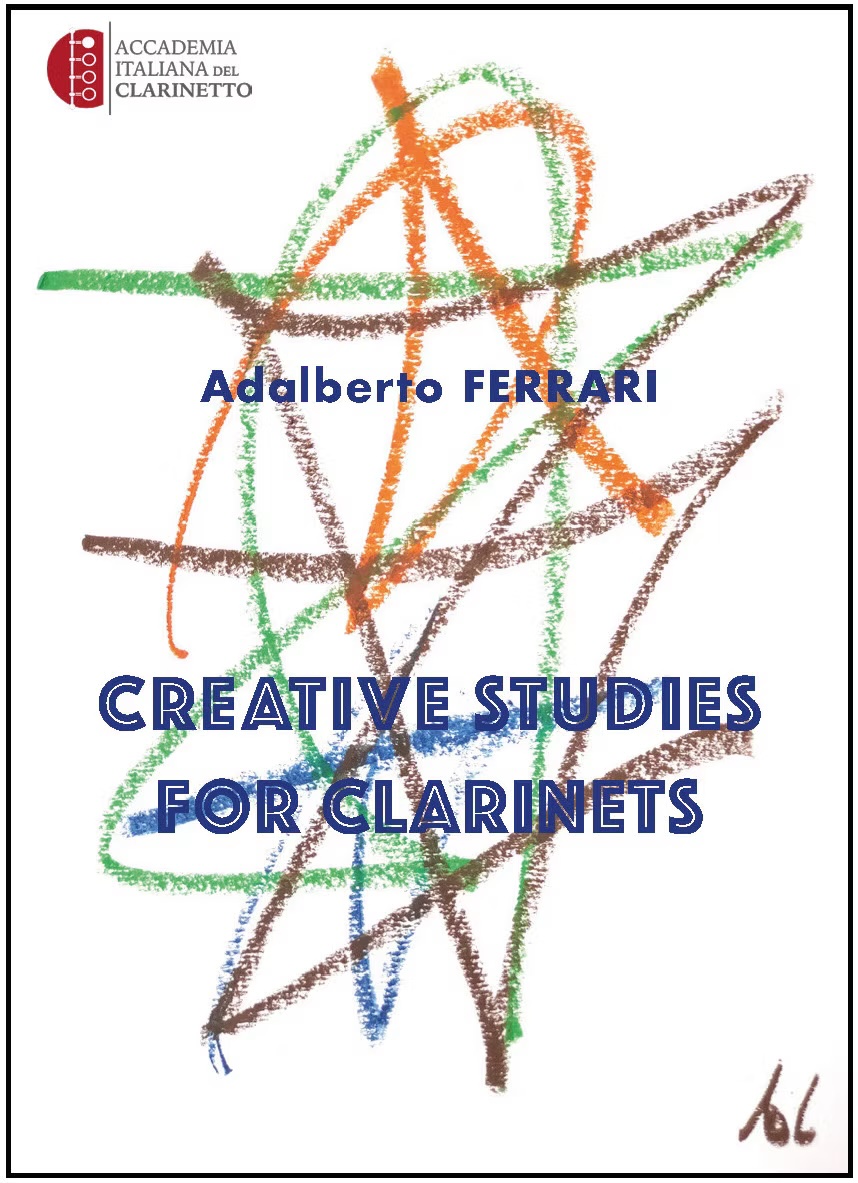
Adalberto Ferrari. Creative Studies for Clarinets. Accademia Italiana del Clarinetto, 2022. 29 pages. €15. AccademiaItalianaClarinetto.com.
Maestro Adalberto Ferrari’s book Creative Studies for Clarinets is a powerful and impactful contribution to clarinet pedagogy for the contemporary clarinetist. It fills a void in existing clarinet pedagogy, which often primarily emphasizes technical development. It does this by presenting studies that challenge one to develop creatively as an artist, beyond the written music. These studies trigger a mindset that provokes the player to focus on creative expression. Ferrari was trained in both classical and jazz idioms, and is deeply committed to integrating this innovative approach—which includes some improvisation—into his teaching and his own performances. The book consists of 10 studies, four of which are versions of other studies in the book, adapted for bass clarinet. The book begins with an introduction in both Italian and English, explaining the pedagogical approach. This is followed by a legend with symbols and effects, followed by a page of suggested scales to be used for the improvisational sections.
These studies are intended for advanced players because of the rhythmic, technical, and range demands, but also because of the courage needed to move beyond the printed page. Certainly, accuracy is an important component of studying these etudes, but taking the risk to improvise is where the real growth potential is. I thoroughly enjoyed working on these, allowing myself to use the phrases, sounds, and ideas as a jumping off point to stimulate creative ideas. These studies are fun, interesting, challenging, and, in my opinion, a necessity for contemporary musicians. Bottom line… get this book and “cultivate your creativity!” We, as clarinetists, need more material like this to blend our quest for precision with inspiration to develop as thoughtful, intuitive, and creative musicians. Bravo, Adalberto!
– John Cipolla
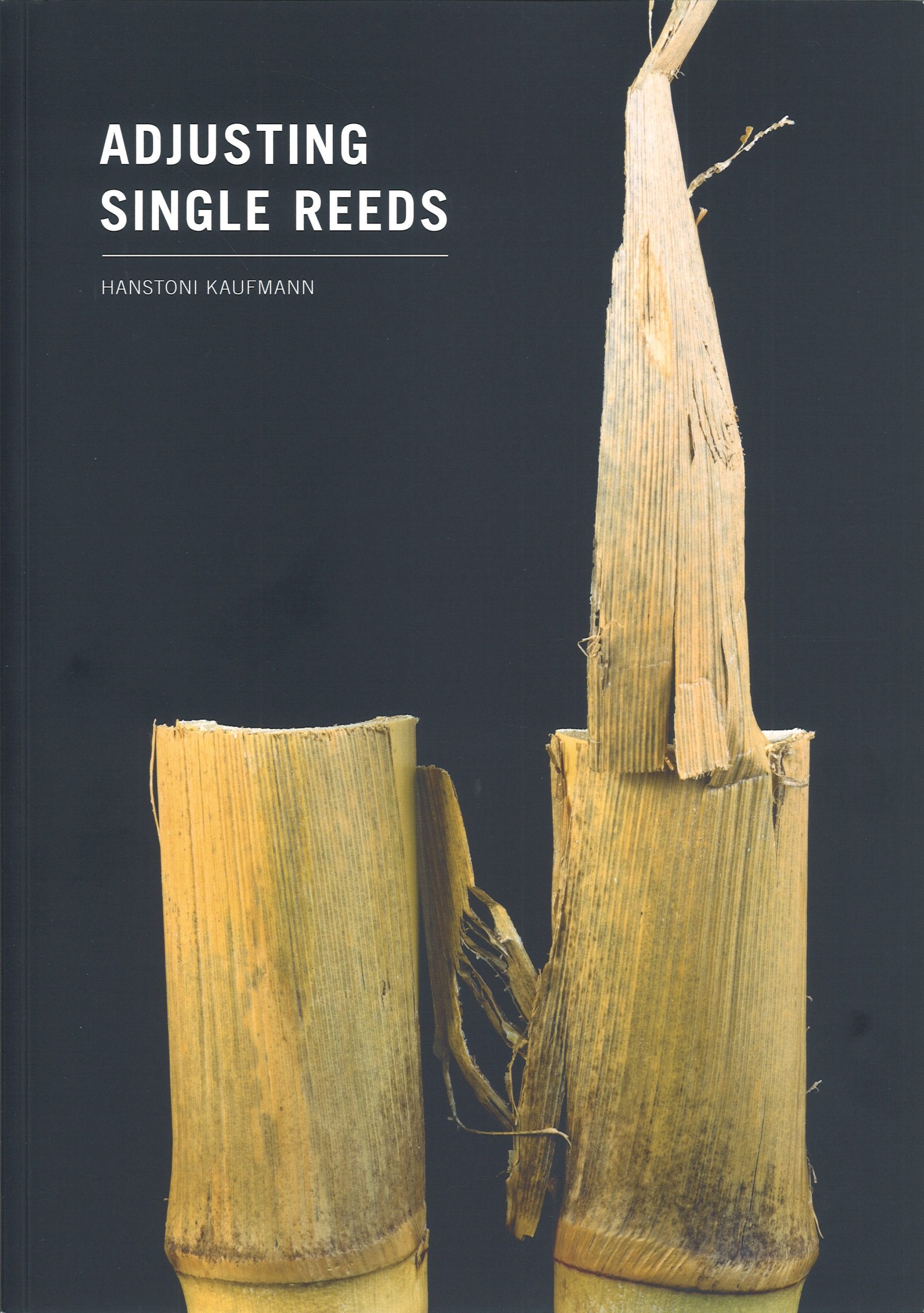
Hanstoni Kaufmann. Adjusting Single Reeds. Translated from German by David Glenn. Finkenburger Musik Verlag, 2020. 39 pages. €31. Amazon.com.
This publication is a well-designed compendium of information not only about adjusting single reeds of various sizes but also about the properties of cane from which reeds are made. The author offers detailed tips on selecting the best reeds, ways of measuring (and the practical meaning of these measurements in terms of their impact on the sound), adjusting, the break-in process, and even reed care. The book is organized into four main chapters: 1) “The Cane,” dedicated to all possible qualities of reed material; 2) “Methods of Reed Adjustment,” a detailed summary of adjusting techniques, necessary tools, and quality/potential control and evaluation tests; 3) “Correcting and Adjusting Methodically,” speaking to the “how to” knowledge of adjusting in a troubleshooting style; and 4) “All Problems Solved?” in which the author addresses cane irregularities that may constitute unsolvable problems to adjust, such as cane’s inter-nodes—one needs to understand to remain impartial to them.
Despite an unquestionable richness of valuable content, this textbook offers no footnotes, bibliography, or references to any other source materials. Such additions would have been particularly helpful in proving the authors claim of cane reeds’ superiority over synthetic reeds in a scientifically informed and non-anecdotal way. The author also makes references to an in-person reed adjusting workshop he offers. It would be very helpful to know if this textbook is a supplement to the workshops or vice versa.
Adjusting Single Reeds is a very much needed tutorial and a solid addition to clarinet literature. The true value of this publication is based on the author’s undeniable experience and observations that span for over three decades; very useful advice on listing, choosing, and using all tools necessary for reed adjusting; and on accessibility of the language used, appropriate to any single reed player regardless of their level of advancement.
– Kornel Wolak
MUSIC
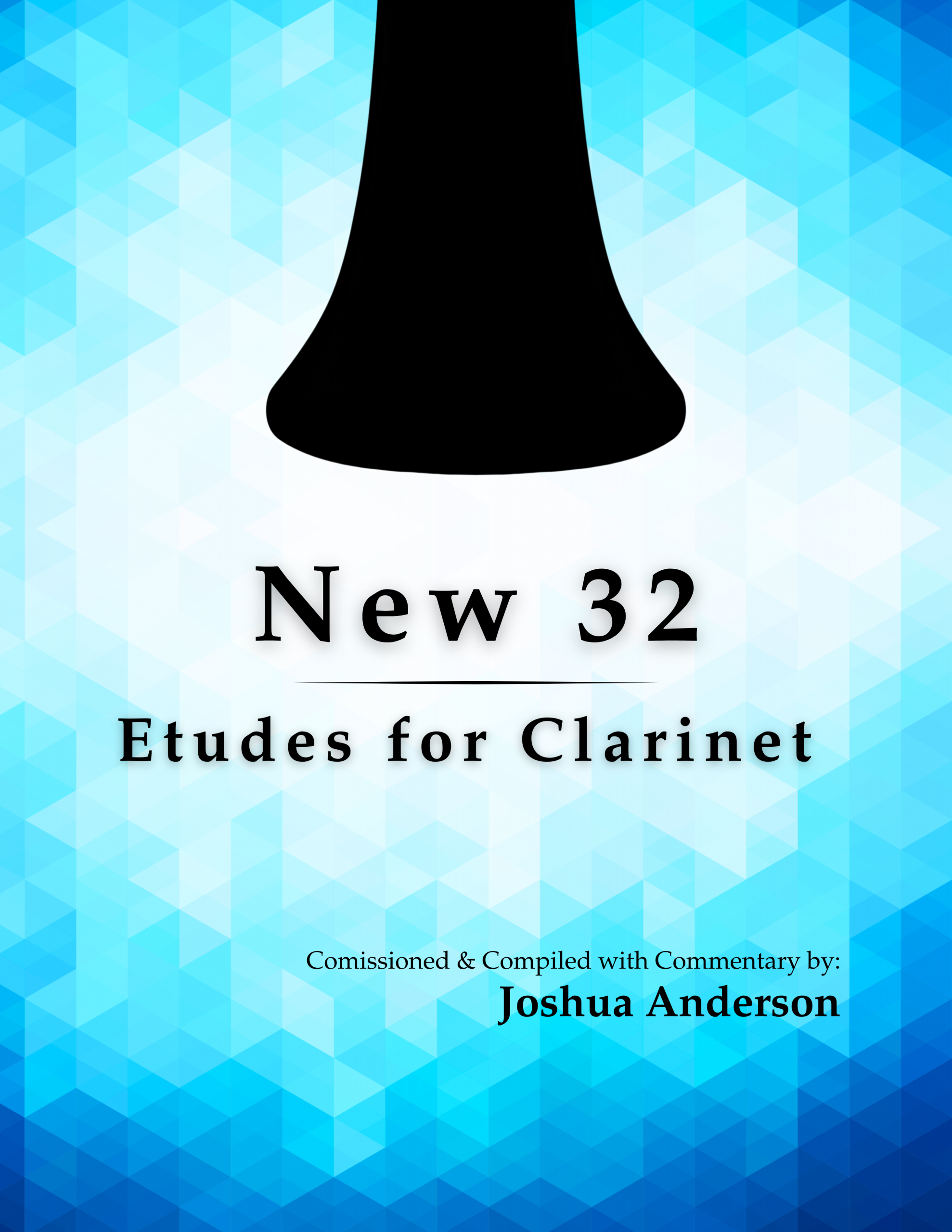
Joshua Anderson. New 32: Etudes for Clarinet. Conway Publications, 2024. 184 pages. $32. Conway-Publications.com.
Joshua Anderson’s New 32: Etudes for Clarinet presents an etude collection written by a diverse group of 16 composers. Anderson, who commissioned and curated these etudes, provides a short study guide for each etude. He gives the player tempo and fingering recommendations and practice suggestions. Joshua Anderson is associate professor of clarinet at the University of Nevada, Reno, and principal clarinet with the Reno Philharmonic.
The New 32 Etudes explores tonalities and techniques of 20th- and 21st-century composition, and challenges players with mixed meters, varied articulation, and lyrical playing, introducing flutter tonguing, glissandi, and more. Each composer offers a pair of etudes in the spirit and level of the Rose 32 Etudes. There are nods to the Rose book including the succession of keys throughout the book (the first pair of etudes in C major, the second two in A minor, etc.), meter, tempo, and occasionally a motive.
The international slate of composers represents broad cultural heritages and unique intersections, hailing from Salvador, India, Singapore, Puerto Rico, China, the United Kingdom and the United States:
- Edilson Ulloa (b. 2000)
- Reena Esmail (b. 1983)
- Gary Powell Nash (b. 1964)
- Emily Koh (b. 1986)
- Sarah Ann Marze (b. 2001)
- Iván Enrique Rodriguez (b. 1990)
- Lorna Katz (b. 1960)
- Monica (Niki) Houghton (b. 1954)
- Scott Perkins (b. 1980)
- Jeremi W. Edwards (b. 1993)
- Wenxin Li (b. 1994)
- Del’Shawn Taylor (b. 1993)
- Will Stackpole (b. 1990)
- Zachary T. Detrick (b. 1999)
- Shuying Li (b. 1989)
Each composer’s pair of etudes explores a single key, typically including a lyrical and technical study, and these pairs increase in difficulty as the book progresses through sharp and flat keys. Teachers can consider assigning these etudes alongside the Rose 32 Etudes or as follow-up study in their curriculum. For example: Begin with the first Rose etude, follow with the first and second etudes in the New 32, return to the Rose book for the third and fourth, and so on as the teacher (and student) feel appropriate.
David Shifrin eloquently sums up my impression of the book in his foreword:
When I received my review copy of the New 32, I eagerly played through the etudes and found myself both charmed and challenged by the diverse styles. Each etude stands as a strong solo composition on its own musical merits. The variety of styles helps to keep the performer interested and engaged while still motivating them to strive for perfection.
After exploring this book and practicing these etudes, I came away particularly enjoying the Hindustani style of Reena Esmail, Emily Koh’s mixed meters, and Shuying Li’s beautifully challenging D-flat major etudes. The scope of these wonderful compositions exposes students and aficionados of clarinet to a host of new voices that represent the extraordinary diversity within our modern-day compositional community. On a personal level, I am extremely excited to introduce this book to my collegiate students and urge all to explore this incredible new etude collection.
– Julianne Kirk Doyle
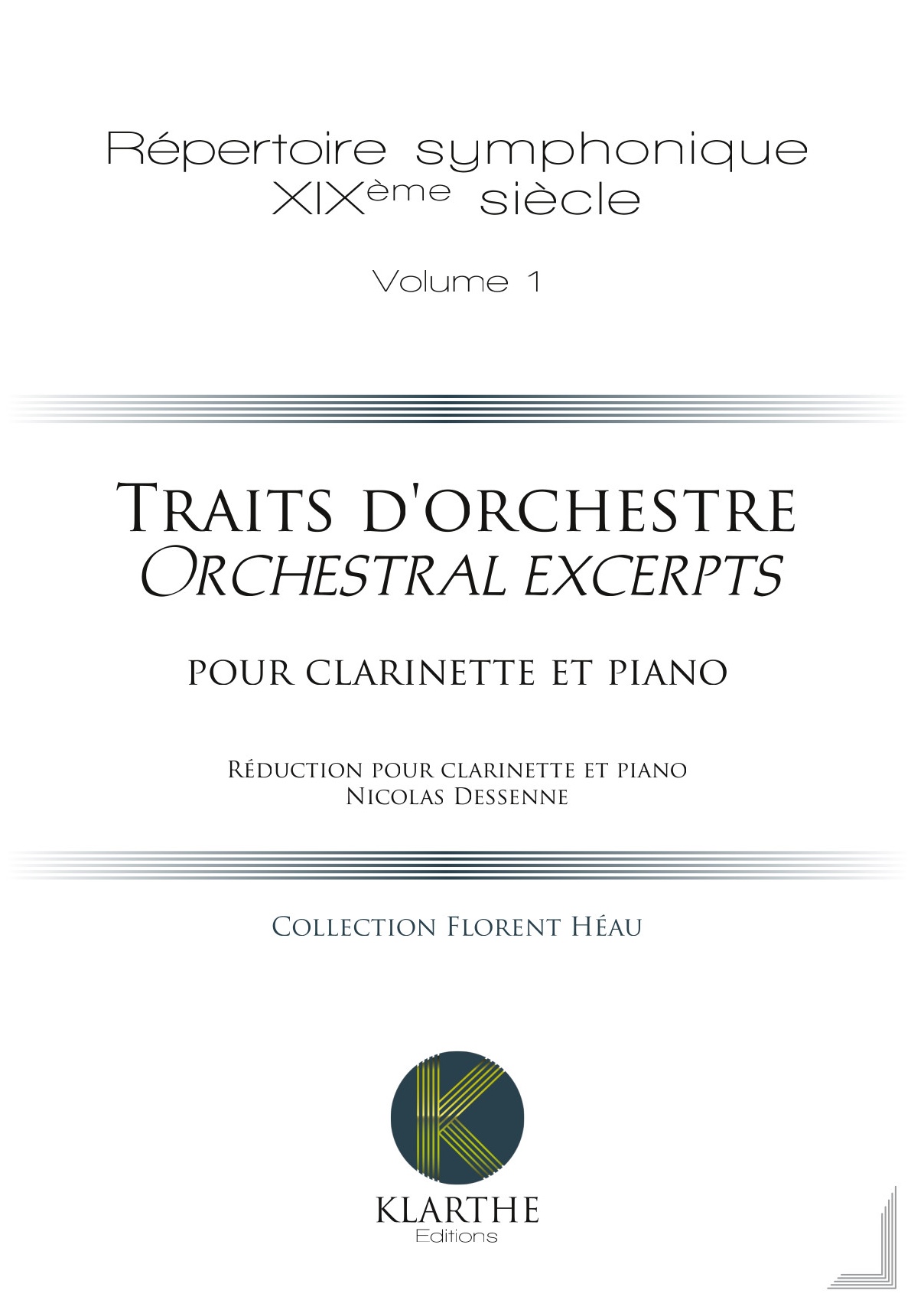
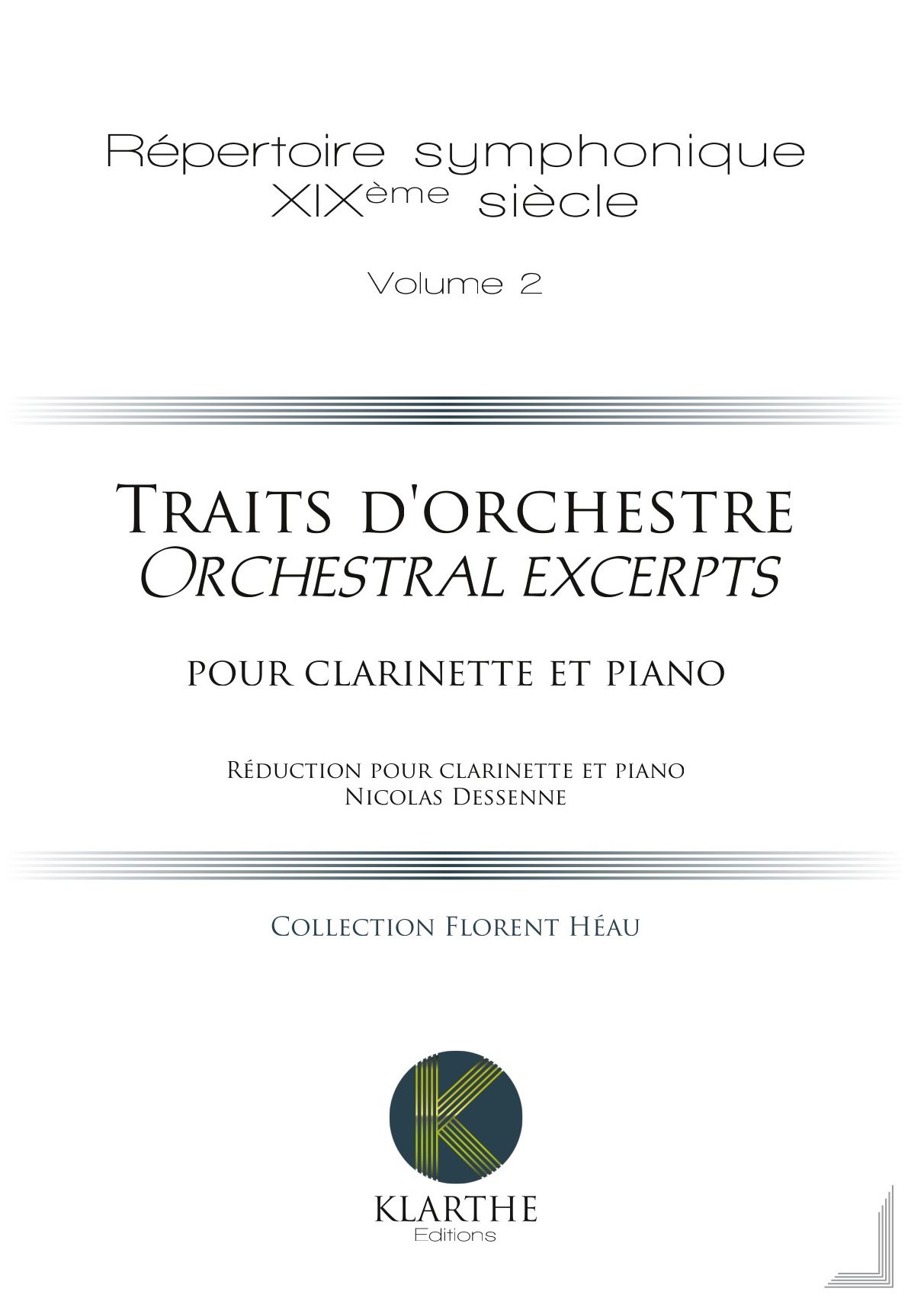
Florent Héau. Orchestral Excerpts for Clarinet and Piano. Piano reduction by Nicolas Dessene. Klarthe Editions, 2024. €26. Klarthe.com.Performance Video.
Florent Héau, the multi-talented French clarinet soloist and teacher, has addressed a gap in the clarinet literature with his new series of books Orchestral Excerpts for Clarinet and Piano. Published by Klarthe Editions and currently in four volumes, it provides piano accompaniments to a number of the most standard solos. Equivalent collections exist for other instruments (Jeanne Baxtresser’s extensive Orchestral Excerpts for Flute with Piano Accompaniment, for example), but to my knowledge this is the first published option for clarinet.
The repertoire is organized by date of composition, with the 19th and 20th centuries each subdivided into two volumes. Selections from the 19th century include Beethoven’s fourth, sixth, and eighth symphonies, Mendelssohn’s Scottish Symphony and “Scherzo” from A Midsummer Night’s Dream, Schubert’s Symphony No. 8, and Tchaikovsky’s Symphony No. 6. Volume 1 of the 20th century includes Kodaly’s Dances of Galanta, Respighi’s Pines of Rome, and Rachmaninoff’s Symphony No. 2. Volume 2 of the 20th century is forthcoming pending copyright permissions and will include Bartok’s Miraculous Mandarin and Shostakovich’s Symphony No. 9.
The piano reductions are by Nicolas Dessenne. He has succeeded at capturing all the important rhythmic and harmonic material from the orchestra and translating it to the keyboard. As demonstrated by Héau and Dessenne in an impressive video montage posted on Vandoren’s YouTube channel, these are concert-level arrangements. They are fairly difficult, however. Even accomplished pianists will need to practice them, and intermediate pianists and those with small hands may need to modify some passages.
Klarthe offers each volume as a PDF download for €26 and a paper edition for €43. From a retail standpoint, an omnibus edition containing all four volumes at a reduced price would be welcome. One further critique is that the current editions lack a separate clarinet part. While most students will have access to the parts from other sources, it would be convenient if a part for the soloist were included.
There is a growing pool of resources available to clarinetists studying the orchestral repertoire and preparing for professional auditions. Books by Daniel Bonade and Peter Hadcock are classics in the category. Additions over the last decade include two volumes of The Audition Method by Mark Nuccio and Benjamin Baron, nine volumes of E-flat clarinet excerpts selected and edited by Jacques Merrer, several new volumes in Michael Drapkin’s bass clarinet excerpt book series, Ralph Skiano’s recent Little Scores for Audition Success and Behind the Screen, and my own Clarinet Excerpts in Context. Florent Héau and Nicolas Dessenne’s Orchestral Excerpts for Clarinet and Piano are a welcome and important contribution to this body of work. Beyond adding to our collective toolbox, they will make practicing excerpts more varied, enjoyable, and fruitful.
– Daniel Friberg
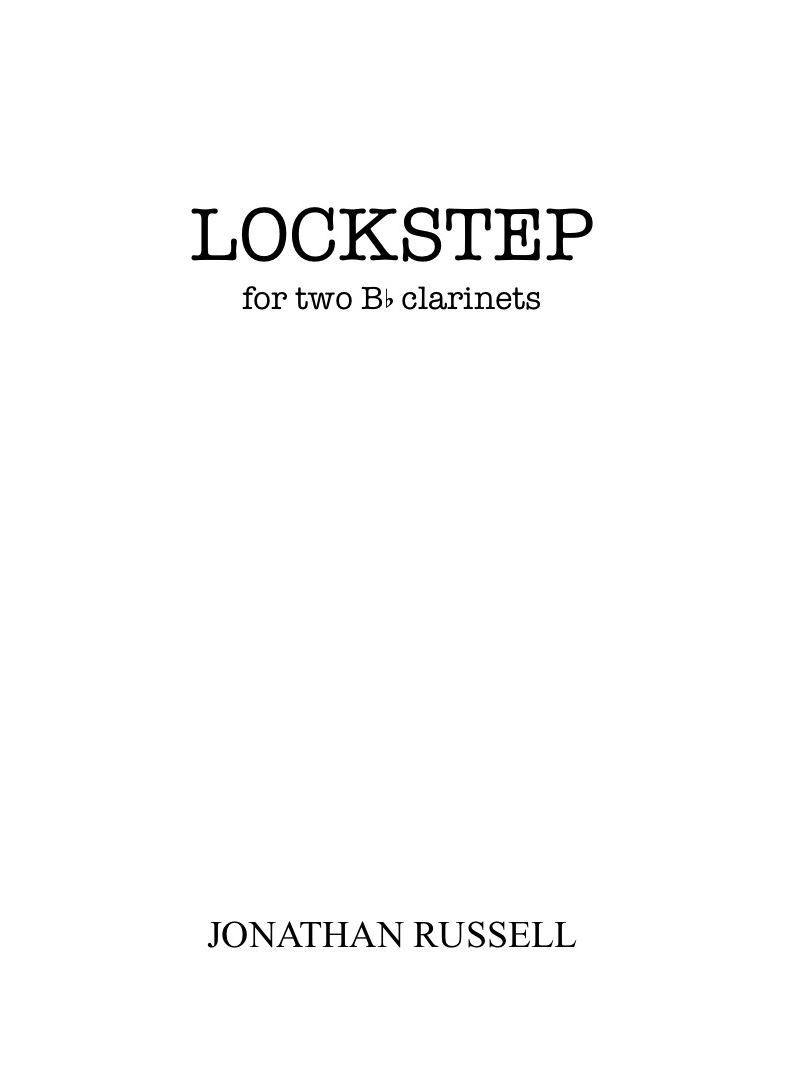
Jonathan Russell. Lockstep for two B-flat clarinets. Self-published, 2021. $30. JonRussellMusic.com. Performance Video.
The Harbinger Duo (Katrina Clements and Vincent Dominguez) commissioned this three-movement work by the prolific composer, clarinetist, and bass clarinetist Jonathan Russell for the ICA’s virtual ClarinetFest® in July 2021. Lockstep for two B-flat clarinets is a demanding, yet achievable duo that maintains equity of part writing throughout, with a clear balance of difficulty level in each voice. Russell uses inventive compositional devices that fit each movement’s title. The entirety of the work could be described as being in “lockstep,” particularly due to the predominance of homorhythmic texture throughout the piece and how the parts are interconnected even when they diverge rhythmically. A significant portion of the first movement, “Just a Second,” is deliberately written just a major second apart. The driving, identical rhythms—save for the short middle section, which trades the melody—account for endurance challenges throughout. Performers will find that this music is an excellent exercise to refine their ability to play expansive intervals, both articulated and slurred. The music, flowing constantly, finally breaks down in the end into fragments to be performed softly over the last 16 bars. The second clarinet opens the second movement, “Lydian Lullaby,” self-described by the composer as “gently rocking” in an ostinato pattern of smooth but wide-ranging intervals. The first clarinet joins, playing the same pattern at a different interval, and eventually the first clarinet plays a beautiful, singing melody atop the established ostinato. In fact, the only time the smooth, swaying motive is not present in the movement is for a few phrases where the initial melody is staggered by one measure and separated by over two octaves at times.
Fittingly named “Going to Eleven,” the third movement is lively and dance-like, written predominantly in 11/16 meter, interspersed with other compound meters. The technical demand is unrelenting, creating an exciting momentum for the performers and audience members alike. Distinct from the previous movements, there are fewer wide interval leaps and instead the presence of many half steps, creating tension as the music progresses. Russell wraps up the work nicely with a reference to the homorhythmic patterns from the first movement, although the material is no longer at the interval of a major second. The range ascends chromatically to an altissimo C7 in the first clarinet part near the end, and there is an option to flutter tongue on this held pitch along with the second clarinet on an altissimo F-sharp. After peaking at this high interval, both clarinets rapidly descend in reverse motion of the work’s opening movement phrase to the very bottom of the instrument.
Jonathan Russell names Lockstep and each movement perfectly in this clever duet. While challenging, it is a terrific addition to the duo repertoire and enjoyable for progressing clarinetists as well as seasoned professionals to prepare for upcoming programs.
– Meghan Merciers
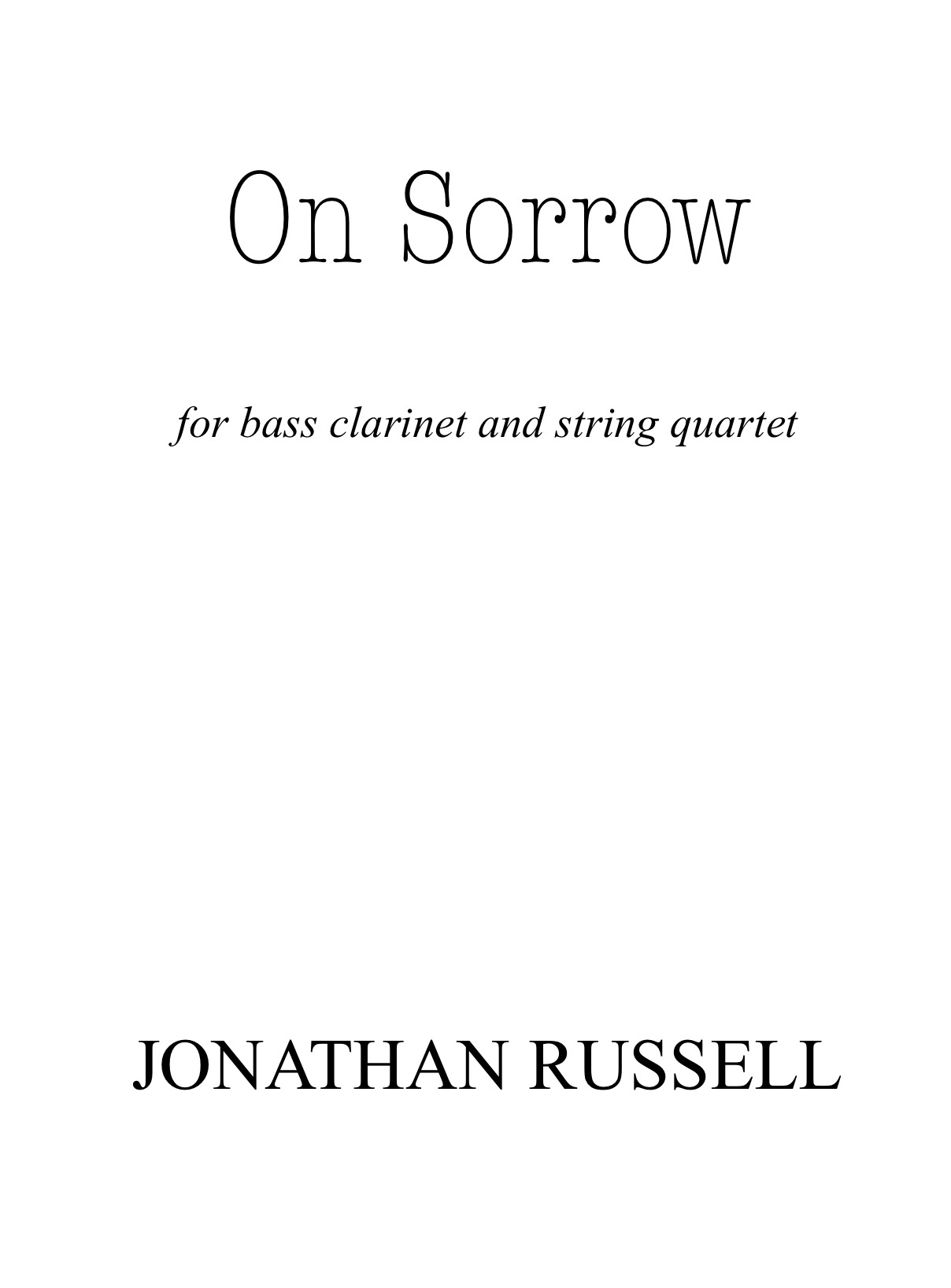
Jonathan Russell. On Sorrow for bass clarinet and string quartet. Self-published, 2018. $65. JonRussellMusic.com. Performance Video.
Expert clarinetist/bass clarinetist and composer Jonathan Russell (b. 1979) describes his music as “seek[ing] to embody and express the full range of human experience in a way that speaks directly to people’s hearts, minds, and bodies.” He accomplishes exactly that in his piece On Sorrow (2018) for bass clarinet and string quartet, drawing on the experience of his wife’s diagnosis of Stage 3 breast cancer in 2017 and how he became “far more conscious of sorrow’s inevitability in all of our lives, of the weight of loss that everyone ultimately carries.” Russell crafts On Sorrow in five movements to be played without pause. He begins the first movement, “Prelude — Loss,” with a motive representing fate: dissonant harmonies repeated almost arrhythmically with a “wispy and ethereal” sound in the strings while the bass clarinet floats above on a treacherously high and delicate line while occasionally joining the strings in their insistent yet ametric music. “Withdrawal,” the second movement, suspends the listener in time and space with a slow pulsation of dissonance in the string quartet accompanying a fragmented, lyrical melodic line in the bass clarinet. Russell centers the bass clarinet part around the clarion and chalumeau registers. The third movement, “Rage,” is the fastest and most driving music in this piece, dominated by a persistent, disjunct groove shared by the bass clarinet and cello. The music whips into a frenzy that finally collapses in a moment of respite for the string quartet before the bass clarinet rudely returns. This is a test of stamina and agility for the bass clarinetist and the string quartet. Russell reintroduces the “fate” motive from the first movement at the climax of this movement, but now with the bass clarinet in its powerful low register and loudest dynamics, helping ease the transition into the fourth movement. Russell constructs “Consolation (O Vos Omnes)” (the fourth movement) entirely out of music from Tomás Luis de Victoria’s 1572 motet O Vos Omnes. He scores this movement exclusively for string quartet, giving the bass clarinetist a needed break while allowing the homogenous timbre of the string quartet to match the purely choral nature of the source material. This is the most tonal movement of the entire piece.
The bass clarinet returns to begin the fifth movement, “Renewal — Postlude.” This movement begins as isolated fragments before slowly developing into a passionate and vivacious tango, pitting the swirling lines of the bass clarinet against the tango figures of the string quartet as though two dancers are fighting for control. The music culminates in a powerful version of the “fate” motive, but now with the bass clarinet wailing away in the altissimo register as an unrestrained lament before arriving in the bright optimism of D major. Russell ends the piece as it began, with soft altissimo in the bass clarinet suspended over the softer “fate” motive. On Sorrow is available for purchase directly from Russell’s website in a digital format, where the score and parts are carefully formatted for maximum legibility and logistical convenience in performance. A stellar live performance of this piece by Jeff Anderle (Russell’s Sqwonk bass clarinet duo partner) and Left Coast Chamber Ensemble is available on YouTube. For the advanced bass clarinetist with a daring string quartet at their disposal, this one is not to be missed!
– David Cook
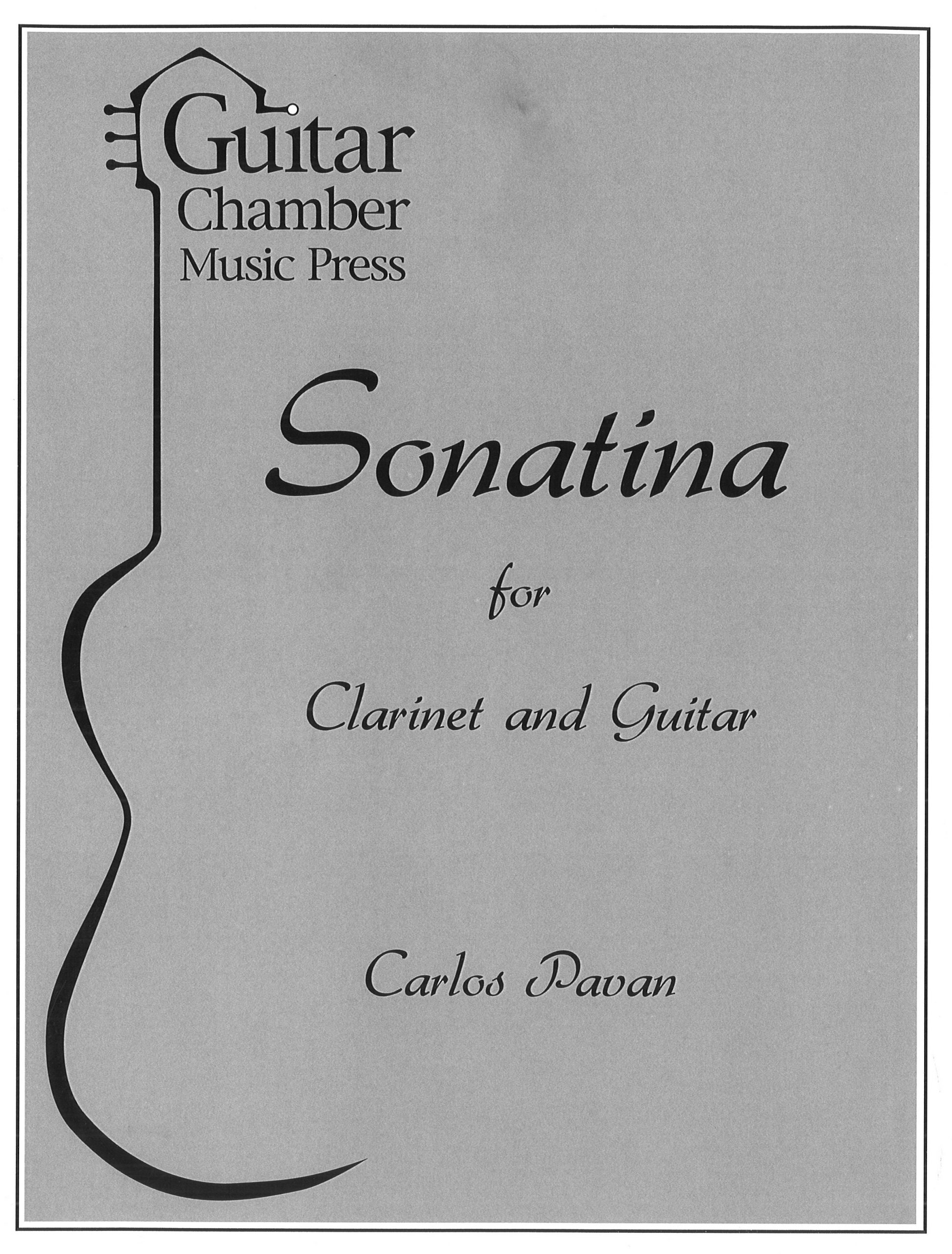
Carlos Pavan. Sonatina for clarinet in B-flat and guitar. Guitar Chamber Music Press. 2024. $12. GuitarChamberMusicPress.com. Performance Video.
Carlos Pavan is an Argentinian guitarist and composer who now lives in New York City. His compositions have been recorded on Centaur Records, and he has received rave reviews from Fanfare and the American Record Guide. His composition Sonatina for clarinet and guitar is a short work (roughly five minutes). The composer describes the work as an Argentine estilo rhythm. The form is a simple ABA. The B section of the form features a short opening cadenza for the clarinetist and a slightly longer cadenza for the guitarist at the end of the section. The work calls for the guitarist to tune their low E string to D concert, down a whole step, an octave below the lowest note on a B-flat clarinet. It does not use many extended techniques, but it does have a couple of flutter-tongued passages and one slap-tongued note. The piece tends to remain in the softer dynamic levels from p to mf, with a single four-bar passage at forte at the work’s climactic point. The work barely crosses into the altissimo register, only to a single D and E-flat.
The piece is easy enough for an established clarinetist, requiring only fluency with scales and a controlled sound. Performances of this work would require a guitarist of equal musicianship, as the work does seem to favor the guitar; its solo cadenza is longer and the guitar’s sound infuses the ensemble sections. This work does not seem to be intended to be the focal point of a recital but would work well as a smaller work in the middle of a concert. It would also make a fine addition to a chamber music concert. Highly recommended.
– Timothy Bonenfant
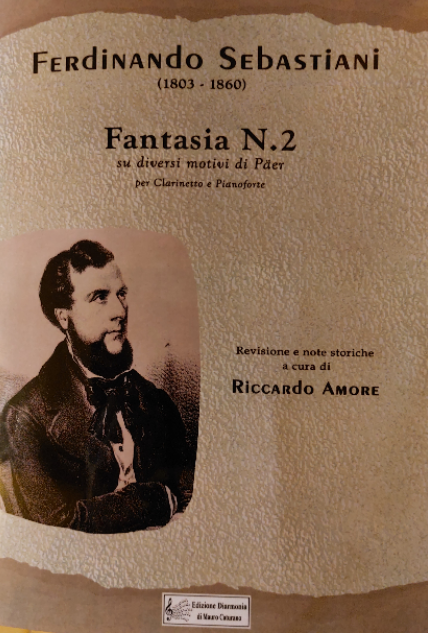
Ferdinando Sebastiani. Fantasia No. 2 on Themes of Paer for B-flat clarinet and piano, edited by Riccardo Amore. Edizione Diarmonia. €19. Diarmonia.it.
Ferdinando Sebastiani (1803-1860) was an eminent Italian clarinetist of the so-called Neopolitan Clarinet School, having as a main principle the technique of the reed on top of the mouthpiece. He was very popular in Naples as an orchestral musician, clarinetist, teacher, composer, and manager. He held the chair of principal clarinet in the orchestras of Real Teatro San Carlo, Teatro del Fondo, and Real Cappella Palatina. He was even able to get the role of giving the A for the tuning to the orchestra. Another very important Italian clarinet virtuoso, Ernesto Cavallini (1807-1874), dedicated to him his Fantasia on Themes from “Sonnambula” of Bellini and Sebastiani in turn gave the name of Ernesto to his newborn son. Sebastiani was held in high esteem by most of the Italian opera composers of his era, and many of them included solo parts with him specifically in mind. We can cite Bellini (I Capuleti e Montecchi), Donizetti (Assedio di Calais, Poliuto), Mercadante (Orazi e Curiazi, Zaira), Pacini (Merope, Saffo, Stella di Napoli), Petrella (I Pirati Spagnoli), and Verdi (Alzira, Luisa Miller). He also collaborated with Gennaro Bosa, clarinet maker of Naples, developing and improving the Mueller system 16-key Neopolitan clarinet used in those times. He taught at the Collegio di Musica of S. Sebastiano (1836-1859) and produced many fine students. He wrote a Clarinet Method (1855), clarinet solo pieces, and opera fantasies, according to the usual practice of the Italian composers of those times, who often were clarinet players. The Fantasia No. 2 on Themes of Paer references works by Ferdinando Paer, an Italian opera composer with Austrian origins. It is published for the first time with an elegant graphic design by Diarmonia and edited by Riccardo Amore, son of the well-known clarinet historian Adriano Amore, author of many interesting books regarding the clarinet in the Italian context. Riccardo also provides a rich preface with information about the composer. This Fantasia is part of the Trois Fantasies sur divers morceaux de Rossini et Paer and has themes from the aria “Ah me deh scendi soave amore” from the opera Camilla (1799) and the overture from the opera Achille. After a long lyrical introduction, we have a cheerful theme and then two brilliant variations and an Allegro with some cadenzas. For those who are fond of clarinet opera fantasies, this is a very good example of that genre, having both beautiful cantabile and virtuoso parts inserted in this new and interesting publication.
– Luigi Magistrelli
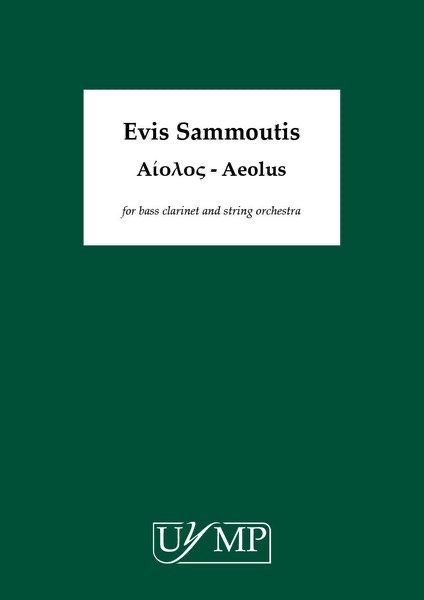
Evis Sammoutis. Aeolus for bass clarinet and string orchestra. University of York Music Press, 2024. Study Score €16.95. Clarinet and string parts available for rental. UYMP.co.uk. Performance Video.
As anyone who has searched for bass clarinet concertos knows, there is a much smaller list of available pieces than for the soprano instrument. Knowing that, it’s always valuable to discover worthy additions to the bass clarinet repertoire. Aeolus by Cypriot composer Evis Sammoutis is just such a work, and bass clarinetists everywhere should take note of this piece. The title of this piece is familiar to those who remember Homer’s Odyssey. In the beginning of the story, Aeolus is the deity who gathers all the rough winds in a bag and gives them to Odysseus, leaving only the gentle West wind to assure his safe travel home to Greece. The Greek god of winds is an evocative subject for a concerto, and this piece explores the dramatic possibilities convincingly.
The opening of Aeolus continues a tradition that has become familiar among unaccompanied solo works: the quiet, breath-sound beginning. In Aeolus, key-click punctuated breath from the bass clarinet echoes as whispery, non-pitched sounds in the strings. These breath-based sounds form an evocative opening that one might expect, given the inspiration of the piece. Tones soon replace air in sweeping, harmonic-series spectra that spill over from the bass clarinet into the strings. The alternation of focus on bass clarinet and string parts gradually evolves into cooperative texture of instruments working together, with the strings echoing and augmenting the increasingly dramatic upward sweeps of the bass clarinet. These harmonic gestures gradually coalesce into a lush sound that is almost Romantic in texture, filling the space with harmonies and resonance. This zenith of energy adds to the lines of the bass clarinet, which rides those sounds as they disperse into supporting roles below the dramatic solo lines. The harmonic-series basis of the piece becomes clarified in a spectral kind of way, extending to the quiet, pensive conclusion that reveals a transformed version of the sounds from the beginning.
At 17 minutes long, this work is an ideal length for programming. The dramatic motion of the piece’s development makes it feel even shorter. Aeolus needs to be on the short list of any bass clarinetist with an opportunity to perform with an orchestra. We’re lucky to have this exciting addition to the repertoire.
– Gregory Oakes
Comments are closed.